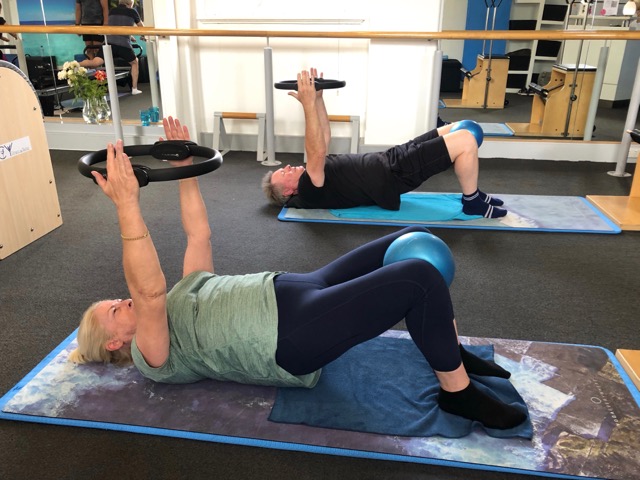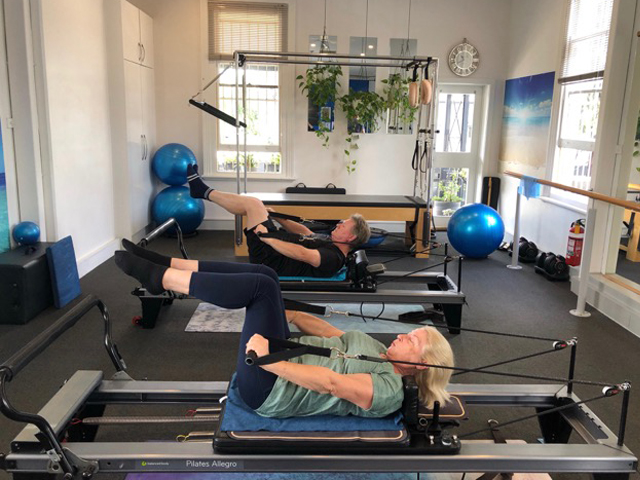
Fiona and Peter; two bodies, one mind-set
Pilates instructors often rate the gratification of assisting clients by contributing to their well-being as high on the list of job benefits; we teach others to better themselves. Another benefit – well, one of mine, at least – is the stimulating experience that unravels when instructing ‘quirky’ clients: those somewhat left-of-centre folk who challenge your thinking, keep you on your toes and do not take themselves too seriously. Similarly, instructing clients who present with a ‘let go and move on with it’ approach to their training is another joy of mine. Both the students and I can accomplish far more than when subjects present with a fixed mindset – the latter often impeding the ability to move forward and progress.
A Pilates partnership
Fiona and Peter (a husband and wife team I teach each week) are quick-witted, light-hearted, relaxed and affable. They recently retired after a long career as specialised seafood restaurateurs and, indeed, they are entertaining, to say the least.
Unique in both their manner and approach, the couple are frank (Peter, especially so) and always ready to make a joke about themselves or each other. Their common goal is working together to improve their quality of life by engaging in the Pilates Method. In fact, working together is fundamental to their practice and, although at times they attend individually, Fiona and Peter much prefer training as a couple: “I love being with my wife” says Peter “plus, you can have a laugh – you’re both embarrassed (together)”. Fiona agrees: “What’s really good is doing Pilates with Peter”. Their adoration for each other (akin to reading prose by Neruda but without all the sentiment surplus) is admirable, inspiring and a pleasure to observe.

Fiona’s Pilates Story
Fiona had regularly attended Pilates classes in Sydney and, after relocating to Adelaide, was on the prowl for a studio that could cater to her specific needs. Her physiotherapist recommended CY Fitness & Pilates in Norwood as they are a reputable studio revered for their small class sizes, professional owners, knowledgeable instructors and ‘tailor-made’ approach to Pilates.
Fiona’s pathologies, her most serious being her asthma, need special consideration: on a difficult day, supine exercises should be kept to a minimum, sitting up may take an extra moment, basal breathing requires some added concentration but, as time progresses, there are fewer challenging episodes during our sessions – of late, I cannot recall many of them at all.
“It’s always been about my asthma – it’s always been severe”, says Fiona. “Pilates helps me with my posture, my breathing and to regain flexibility and strength. It’s also a gentler form of exercise, even though it sometimes kills me the next day”, she says with a cheeky giggle.
When I first met Fiona over a year ago, it was obvious that she had an astute understanding of the basic technique and fundamental principles that form the basis of the Pilates Method. However, as with every person’s practice, there is always something to tweak or progress and Fiona works diligently to do so. Aside from controlling her asthma, improving her plantar fasciitis and correcting her foot and knee alignment are Fiona’s additional goals. We have been working on improving her lower extremity alignment for some time, especially in positions during which her feet are in contact with a surface that provides her with proprioceptive feedback. I suspect Fiona’s uneven weight distribution through the soles of her feet and medial placement of her patella may contribute to her battle with this foot pathology.
Aware of the positive effect of Pilates, Fiona reveals: “I have had very little of it (plantar fasciitis) since I have been doing Pilates”; this painful pathology is being kept at bay. Fiona attributes much of her Pilates success to the low teacher to student number ratio in her sessions: “Based on my experience, find a small class with individual instruction – that’s how you get the most out of it – you need someone to correct you”.
Peter’s Pilates Story
Peter also has a few niggles yet is a different kettle of fish (quite fittingly). The reason he first attended Pilates was: “Fiona telling me I had to go”. In his typical unapologetic fashion, he then adds: “I always thought it was for women!”. Thankfully, he has changed his tune and now believes that others should: “START NOW! Straight away; don’t delay, there should be no delay whatsoever; you’re wasting time otherwise”.
Following Peter’s newly found conviction, he is adamant that Pilates has positively impacted his life: “It gives you much more confidence when you’re more flexible and mobile, especially when you’re going out in crowds”, he says, attributing this extra confidence to having “much more balance and strength”.
Another of Peter’s achievements is a result of his regular Pilates practice (three times a week on average) and his fervent 20-minute daily commitment to lengthening his spine and elongating his hamstrings by sitting with his back up against a wall or couch whilst watching television. This dedication to working on his elasticity has resulted in a considerable improvement in his functional movements and his ability to roll down, roll up and roll through his spine.
Prior to engaging in the Pilates Method, Peter had trouble feeding his belt through the back loops of his trousers; he can now perform this task without assistance. He also boasts: “Bending down is so much easier… and so is giving the dog its daily insulin injection” (Pilates for dogs anyone?).
Much of Peter’s ‘dysfunctional’ movement patterns are the result of his shoulder injuries (we also know that dysfunction in muscle functioning also leads to injuries therefore vice-versa can also be true). He has undergone several shoulder and hand surgeries including a shoulder reconstruction. On the occasions that Fiona is absent, I focus specifically on Peter’s shoulder stability and range of motion, rhomboid strength and lengthening both pectoralis major and minor. It could be said that Peter’s thoracic kyphosis has also contributed to his shoulder being unwell, so I work towards him ‘growing taller’ and balancing the base of his skull on his occiput.
Finding the Mid-Point
Teaching this dynamic duo is not merely an entertaining pleasure; Fiona and Pete have also led me to rekindle my interest in reflecting upon personality types and how character traits impact both the apprehension of the Pilates Method and the outcome of regular Pilates practice. I have noticed that several aspects of Fiona and Peter’s similar personalities have contributed to their successful progression and improvement as Pilates students. Namely, they have struck a balance between holding on and letting go.
Their ‘have a good laugh’ attitude enables the three of us to work in a relaxed environment; Fiona and Peter do not fear judgment on my part (well, perhaps maybe a little); they front challenges and obstacles without being attached to what could be perceived as failure if the outcome is not what they desired; in short, ‘letting go’ is embedded in their approach.
At the other end of this spectrum, ‘holding on’ is also one of this couple’s fortes. Their sharp minds and fine motor skills permit them to remember and repeat which, in my view, is comparable to ‘holding on’ to both a memory and a previously performed pattern of movement.
Looking at the Flip Side
As with everything, there is always a flip-side to consider: if we cling to something excessively we get stuck and, in the case of Pilates, it is often our habitual movement patterns that we are attached to and find difficult to part with – another form of ‘holding on’ that we are all guilty of. Conversely, if we continuously disconnect then our ability to remain steady is compromised and, in the case of Pilates, this could interfere with our ability to concentrate, harness control, increase our strength, create muscle memory or manage hypermobility (Lisa Anthony presented a marvellous workshop about hypermobility at the 2021 PAA Conference).
Many Pilates instructors – and I confess I fall into this category – cue students to “switch on”, “hold”, “squeeze”, “tighten”, “brace” and “engage” a range of muscles. Yes, instructors also ask students to “lengthen”, “open”, “elongate” “stretch” “reach” and “relax” but are we placing an even amount of importance on both ends of the spectrum or do we tend to favour one end of this (Pilates) arc? Is it our either excessive or inadequate tension that prohibits us from achieving balance; the state of equilibrium and homeostasis (both crucial to our well-being) that oftentimes evades us?
Holding on (to muscles, to technique, to corrections, to movement patterns,) is essential to progressing any movement-based practice. Letting go (of these) is of equal benefit. Finding a mid-point between these extremes is fundamental if we are to experience the myriad of ways in which our bodies function and achieve balance so that harmony can prevail: “Not too much, not too little”.
Now back to Fiona and Peter whose carefree approach to Pilates, and life in general, is all but laissez-faire. This ‘quirky’ couple are diligent perfectionists who strive to gobble up every cue given and each correction offered. Notwithstanding their ability to remain focused, having a cackle is high on their list of Pilates benefits. Last week, when I accidentally told them to: “put your knee between your balls” (oh, dear), I realised their infectious behaviour may have subconsciously rubbed off on me… and another laugh we shared!
Daniela Di Fabio, PAA Committee Member


Comments are closed.